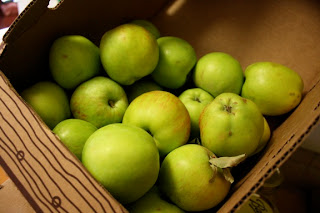 Yesterday, the Montavilla Farmers Market hosted a community forum to discuss food access and equity issues. Thanks to a donation from Grand Central Baking Co. we had a beautiful pile of rolls and whole grain bread loaves left over at the end of the day. I love bread and can't seem to keep a loaf around long enough to use in recipes that call for day-old bread. Bread pudding, croutons, bread crumbs, french toast. So many uses for something that some people would consider past its prime, but for me is just aging to perfection. This unexpected windfall came at just the right moment.
Yesterday, the Montavilla Farmers Market hosted a community forum to discuss food access and equity issues. Thanks to a donation from Grand Central Baking Co. we had a beautiful pile of rolls and whole grain bread loaves left over at the end of the day. I love bread and can't seem to keep a loaf around long enough to use in recipes that call for day-old bread. Bread pudding, croutons, bread crumbs, french toast. So many uses for something that some people would consider past its prime, but for me is just aging to perfection. This unexpected windfall came at just the right moment. Today after the market, the board is throwing a thank you potluck party for our volunteers and vendors. I decided to use the bread in a bread and tomato salad. The close runner up was an Apple Cardamom Bread Pudding from the same cookbook, but the unexpected bounty of tomatoes from my garden helped make the decision.
Today after the market, the board is throwing a thank you potluck party for our volunteers and vendors. I decided to use the bread in a bread and tomato salad. The close runner up was an Apple Cardamom Bread Pudding from the same cookbook, but the unexpected bounty of tomatoes from my garden helped make the decision. Crouton Salad
Crouton Saladadapted from Mark Bittman's How to Cook Everything Vegetarian
8 oz crusty bread (a few days old is best)
1/4 c olive oil
2 Tbsp red wine vinegar or lemon juice
2 ripe tomatoes, cored and roughly chopped
1 small red onion, halved and thinly sliced
1 clove garlic, minced or pressed
salt and fresh ground black pepper
1/4 c roughly chopped basil or parsley
Heat the oven to 400 degrees. Cut the bread into large cubes and spread on baking sheet. Bake for 15-20 minutes, until golden and toasty. Let cool.
In another bowl, mix oil, vinegar, tomatoes, onion, garlic. Sprinkle with salt and pepper. Toss to mix everything well. Add the toasted bread and basil or parsley.

Another twist on this recipe is tossing the bread salad with any kind of greens (kale, chard, spinach) that have been sauteed with onion, red pepper flakes. Toss in a handful of currants or raisins and toasted pine nuts. Sounds like something that would be good for later in the season when tomatoes have faded to a memory.







